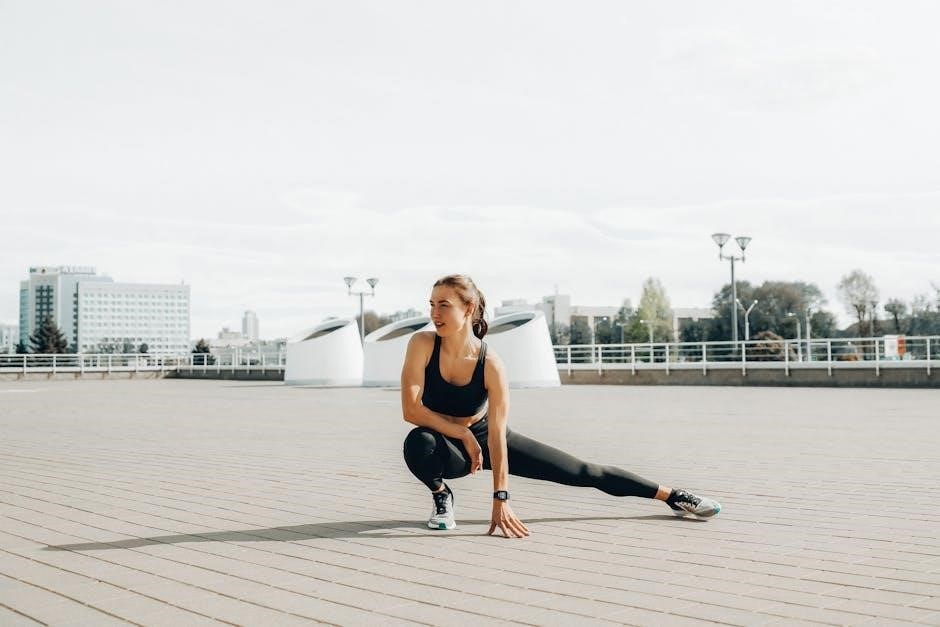printable rotator cuff exercises pdf
- Published
- in United Kingdom
Rotator cuff exercises are essential for maintaining shoulder stability and relieving pain, typically performed with gentle movements and progressing gradually to strengthen muscles over time naturally.
Purpose of Rotator Cuff Exercises
The purpose of rotator cuff exercises is to improve shoulder function and reduce pain, by strengthening the muscles and tendons that surround the shoulder joint, and improving flexibility and range of motion.
These exercises can help to prevent further injury and improve overall shoulder health, and are often used as a form of rehabilitation after a shoulder injury or surgery.
A well-structured exercise program can help to improve proprioception, which is the ability to sense the position and movement of the shoulder joint, and can also help to improve functional abilities, such as lifting and reaching.
The exercises can be modified to suit different levels of fitness and ability, and can be performed at home or in a clinical setting, with the guidance of a healthcare professional or physical therapist, to ensure safe and effective progression.
Regular exercise can help to reduce the risk of future injury and improve overall quality of life, by maintaining healthy and strong shoulder muscles and joints.
Importance of Exercise in Rotator Cuff Rehabilitation
Exercise plays a crucial role in rotator cuff rehabilitation, as it helps to restore strength, flexibility, and function to the affected shoulder.
A well-structured exercise program can help to promote healing, reduce pain and inflammation, and improve range of motion.
Regular exercise can also help to prevent further injury and improve overall shoulder health, by strengthening the muscles and tendons that surround the shoulder joint.
Additionally, exercise can help to improve proprioception, which is the ability to sense the position and movement of the shoulder joint, and can also help to improve functional abilities, such as lifting and reaching.
The importance of exercise in rotator cuff rehabilitation cannot be overstated, as it is a key component of the rehabilitation process, and can help to ensure a successful recovery and return to normal activities.
Exercise can be modified to suit different levels of fitness and ability, and can be performed at home or in a clinical setting;

Types of Rotator Cuff Exercises
Various exercises exist, including stretching and strengthening exercises, to help improve shoulder function and reduce pain naturally over time always slowly.
Examples of Typical Rehabilitation Exercises
Typical rehabilitation exercises for rotator cuff injuries include pendulum exercises, arm circles, and shoulder blade squeezes, which help improve range of motion and strengthen surrounding muscles.
These exercises are often performed with the affected arm at the side, and can be progressed to include resistance bands or light weights.
The goal of these exercises is to promote healing, reduce pain and inflammation, and restore functional mobility to the shoulder joint.
A physical therapist or healthcare professional can provide guidance on proper technique and progression of exercises.
It is essential to start slowly and gradually increase the intensity and duration of exercises to avoid exacerbating the injury.
By incorporating these exercises into a rehabilitation program, individuals can effectively manage their rotator cuff injury and promote optimal recovery.
Regular exercise and physical therapy can help improve outcomes and reduce the risk of future injuries.
Proper exercise technique and progression are crucial for effective rehabilitation.
Starting Positions for Rotator Cuff Exercises
Starting positions for rotator cuff exercises vary depending on the specific exercise, but often involve standing or sitting with good posture.
The affected arm may be at the side, or held out to the side at shoulder height.
Some exercises, such as pendulum exercises, involve bending over at the waist to allow the arm to hang freely.
Others, such as shoulder blade squeezes, involve standing or sitting with the affected arm at the side and squeezing the shoulder blades together.
Proper starting position is essential for effective and safe exercise performance.
A physical therapist or healthcare professional can provide guidance on proper starting positions and technique.
It is essential to maintain good posture and engage the core muscles to support the back and promote effective exercise performance.
By starting in the correct position, individuals can ensure a safe and effective exercise routine.
This helps to prevent further injury and promote optimal recovery from rotator cuff injuries.

Creating a Rotator Cuff Exercise Program
Programs typically involve a series of exercises and stretches to improve shoulder function and reduce pain naturally over time with gentle movements and progression.
Number of Exercises per Session
A session should contain a limited number of exercises to avoid overexertion and prevent further injury, typically ranging from 1 to 4 main exercises per session.
The exercises can be varied and performed on different days, allowing for adequate rest and recovery time in between.
This approach enables individuals to focus on specific exercises and gradually progress to more challenging ones, promoting overall shoulder health and stability.
By limiting the number of exercises per session, individuals can also better monitor their progress and adjust their routine as needed, ensuring a safe and effective rehabilitation process.
The key is to strike a balance between exercising regularly and avoiding overexertion, which can be achieved by carefully selecting a few targeted exercises per session and performing them with proper technique and control.
This structured approach can help individuals make steady progress and achieve their rehabilitation goals, ultimately leading to improved shoulder function and reduced pain.
Frequency of Exercises
The frequency of exercises is crucial in a rotator cuff rehabilitation program, with most programs recommending exercises to be performed several times a week.
A typical schedule may involve exercising 2 to 3 times per week, with at least one day of rest in between to allow for recovery and muscle rebuilding.
This frequency allows for consistent progress and strengthening of the muscles, while also minimizing the risk of overuse and injury.
The exercises can be performed on alternate days, such as Monday, Wednesday, and Friday, or on consecutive days with a day of rest in between.
Consistency is key, and individuals should aim to establish a regular exercise routine to achieve optimal results and promote long-term shoulder health.
By exercising at a consistent frequency, individuals can make steady progress and achieve their rehabilitation goals, ultimately leading to improved shoulder function and reduced pain over time naturally.

Duration of Rotator Cuff Exercise Program
Typically lasts several weeks to months, with gradual progression and exercises adjusted accordingly over time naturally always.
Length of Program
The length of a rotator cuff exercise program can vary depending on the individual’s condition and progress. According to the information, a shoulder conditioning program should be continued for 4 to 6 weeks, unless otherwise specified by a doctor or physical therapist. This timeframe allows for gradual strengthening of the muscles and improvement in shoulder stability. It is essential to follow the recommended duration to achieve optimal results and prevent further injury. The program’s length may be adjusted based on the individual’s response to the exercises and their overall progress. A healthcare professional can provide guidance on the appropriate length of the program and make any necessary adjustments. The goal is to complete the program and achieve significant improvement in shoulder function and pain reduction. Regular exercise and stretching can help maintain shoulder health and prevent future problems. A well-structured program is essential for effective rehabilitation;
Progressing Through the Program
Progressing through a rotator cuff exercise program involves gradually increasing the intensity and difficulty of the exercises as the individual’s strength and flexibility improve. This can be achieved by adding more repetitions, sets, or weight to the exercises. It is essential to progress at a pace that allows the muscles and joints to adapt without causing excessive stress or pain. A healthcare professional can provide guidance on how to progress through the program safely and effectively. The goal is to continue challenging the muscles and joints to promote further improvement and prevent plateaus. Regular assessments and adjustments to the program can help ensure continued progress and optimal outcomes. By progressing through the program, individuals can achieve significant improvements in shoulder function and reduce their risk of future injury or dysfunction. Effective progression requires careful planning and monitoring to ensure a successful rehabilitation outcome.

Managing Pain and Discomfort
Pain and discomfort are managed with gentle exercises and gradual progression to avoid exacerbating the condition naturally and effectively always.
Easing Off Exercises with Pain
Easing off exercises with pain is crucial to avoid aggravating the condition and allowing for proper healing. According to online resources, it is essential to start each exercise slowly and ease off if pain occurs. This approach enables individuals to progress gradually and strengthen their muscles without exacerbating the condition. The internet provides various resources, including printable rotator cuff exercises pdf, which offer guidance on managing pain and discomfort. These resources emphasize the importance of gentle movements and gradual progression. By easing off exercises with pain, individuals can ensure a safe and effective rehabilitation process. This approach is vital for maintaining shoulder stability and relieving pain, ultimately leading to successful rehabilitation and improved overall well-being, with exercises and stretches playing a critical role in the recovery process, as stated online.
